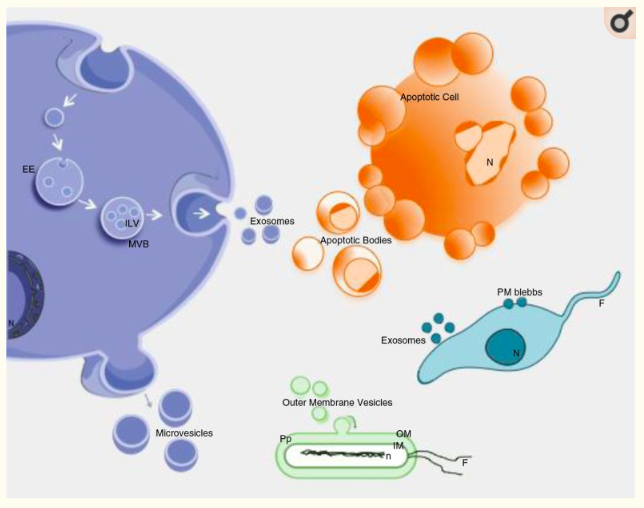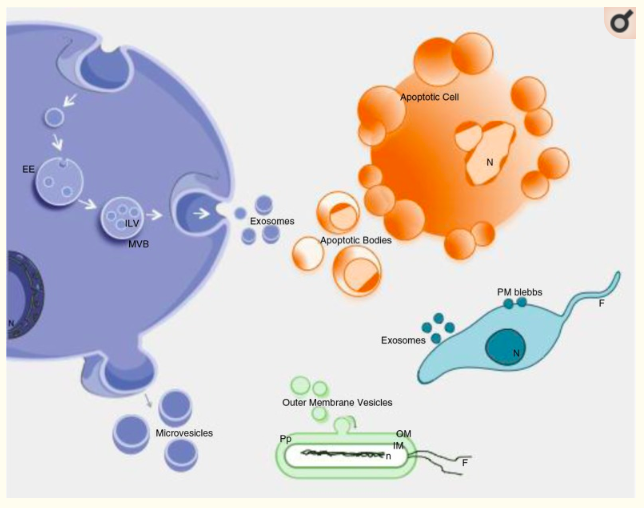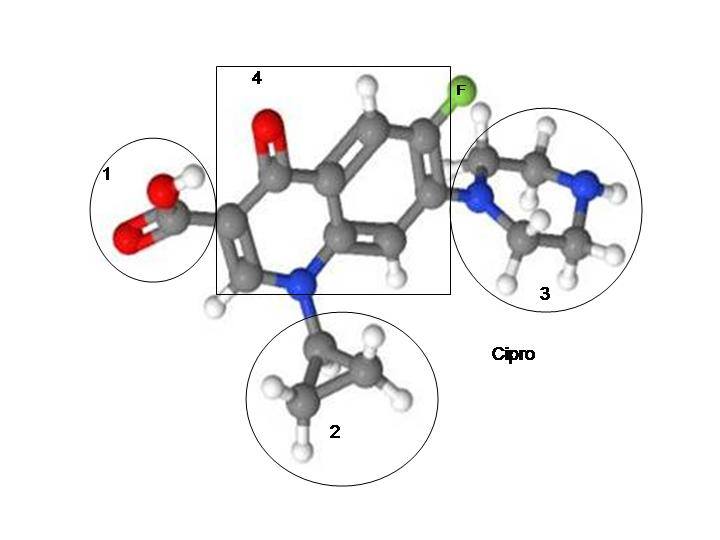
Journal of Extracellular Vesicles, “Biological properties of extracellular vesicles and their physiological functions”
The study, “Antibiotic-induced release of small extracellular vesicles (exosomes) with surface-associated DNA” published in Nature, found that, “ciprofloxacin induced the release of both DNA (mitochondrial and chromosomal sequences) and DNA-binding proteins on the exofacial surfaces of small extracellular vesicles referred to in this paper as exosomes.” And, “Our results reveal for the first time that prolonged low-dose ciprofloxacin exposure leads to the release of DNA associated with the external surface of exosomes.”
In the discussion section of “Antibiotic-induced release of small extracellular vesicles (exosomes) with surface-associated DNA” the authors expand on their findings:
“Exposure of Jurkat cells to ciprofloxacin has been shown to induce oxidative stress, production of reactive oxygen species, mitochondrial dysfunction, inhibition of the respiratory chain and decrease of mitochondrial membrane potential leading to mitophagy47. Our MS analysis has also confirmed the above biological processes in Jurkat cells. Importantly, the presence of ciprofloxacin has been reported to lead to the loss of mtDNA28, 29 and an aneuploidy caused by the genotoxic stress of Jurkat cells30, 48. Genotoxic stress response has been shown to induce the release of nucleosomes by leukemic myeloid cells49. In the present study, mitochondrial damage of ciprofloxacin-exposed Jurkat cells has been evidenced by the abundance of mtDNA, and the nucleoid protein FEN1, as well as numerous other mitochondrial proteins in the secreted vesicles. Ciprofloxacin inhibits both the bacterial DNA gyrase and the mammalian topoisomerase II enzymes responsible for proper DNA replication50. Given that ciprofloxacin mainly inhibits the mitochondrial isoform of mammalian topoisomerase II29, its presence induces mtDNA fragmentation as well as subsequent gradual decrease in mtDNA content29.”
And also note that:
“We found that the exosomal DNA release-inducing effect was not solely observed in the case of Jurkat cells as we also detected ciprofloxacin-induced release of exofacial EV DNA in the case of the pancreatic cancer cell line MiaPaCa. These results demonstrate that DNA-associated EVs may be released from various types of cells after long-term ciprofloxacin exposure.”
These findings are interesting, and I think consequential and explanatory.
But, I am guessing that most people reading this need some more information about what the excerpts above mean. I know I did (and I had to read it about five times).
First, understanding “Antibiotic-induced release of small extracellular vesicles (exosomes) with surface-associated DNA” requires a little knowledge of what extracellular vesicles and exosomes are.
Extracellular vesicles (EVs) are “lipid bilayer-delimited particles that are naturally released from a cell and, unlike a cell, cannot replicate. EVs range in diameter from near the size of the smallest physically possible unilamellar liposome (around 20-30 nanometers) to as large as 10 microns or more, although the vast majority of EVs are smaller than 200 nm. They carry a cargo of proteins, nucleic acids, lipids, metabolites, and even organelles from the parent cell. Most cells that have been studied to date are thought to release EVs, including some bacterial, fungal, and plant cells that are surrounded by cell walls. A wide variety of EV subtypes have been proposed, defined variously by size, biogenesis pathway, cargo, cellular source, and function, leading to a historically heterogenous nomenclature including terms like exosomes and ectosomes.” (Source)
Exosomes are a subtype of extracellular vesicles. “Exosomes are best defined as extracellular vesicles that are released from cells upon fusion of an intermediate endocytic compartment, the multivesicular body (MVB), with the plasma membrane.” (Source) More information (that’s only basic if you have a heavy science background) about exosomes can be found in “Q&A: What are exosomes, exactly?”
Basically, they’re molecules secreted from cells that affect other cells (sometimes positively, sometimes negatively).
Here’s a series of videos that give a really high-level, shiny and high-production-value explanation of exosomes and extracellular vesicles:
Additionally, here are some interesting tidbits about extracellular vesicles (EVs) and exosomes gathered from various articles:
“In the past decade, extracellular vesicles (EVs) have been recognized as potent vehicles of intercellular communication, both in prokaryotes and eukaryotes. This is due to their capacity to transfer proteins, lipids and nucleic acids, thereby influencing various physiological and pathological functions of both recipient and parent cells. While intensive investigation has targeted the role of EVs in different pathological processes, for example, in cancer and autoimmune diseases, the EV-mediated maintenance of homeostasis and the regulation of physiological functions have remained less explored.” (Source)
“EVs alone regulated the expression of numerous genes related to inflammation and signaling.” (Source)
“EVs are carriers of pathogen-associated and damage-associated molecular patterns, cytokines, autoantigens and tissue-degrading enzymes. In addition to a possible role in the pathogenesis of a number of inflammatory conditions, such as infections and autoimmune diseases, EVs, including microvesicles (also known as microparticles), exosomes and apoptotic vesicles, have therapeutic potential and might be used as biomarkers for inflammatory diseases.” (Source)
“another significant role of EVs has emerged in the removal of unwanted molecular material as a means for cell maintenance.” (Source)
“This report is the first show that numbers of blood-derived EVs are elevated in patients suffering from CFS/ME, indicating their potential involvement in disease pathogenesis. This promising finding may not only provide insights into the mechanisms involved in the disease but also shows that EVs may be useful for early diagnosis of illness. Moreover, isolation of circulating EVs coupled to our prototype for their detection by LFIA may constitute a powerful diagnostic tool, which can be performed in a single step and in minutes. We concluded that EVs may play a critical role in CFS/ME. Studies with larger sample size, outcome measures and different study designs (i.e. cross-sectional vs. longitudinal cohorts) are now urgently needed. These studies should stratify subgroups according to illness onset and progression, and assess patients at baseline and following induction of post-exertional malaise (PEM), using the 2-day cardiopulmonary exercise test (CPET).” (Source)
“Mast cells, being capable of both degranulation and subsequent recovery, have recently attracted substantial attention as also being rich sources of secreted extracellular vesicles (including exosomes and microvesicles).” (Source)
Both extracellular vesicles and exosomes contribute to processes that are related to many illnesses (including multi-symptom chronic illnesses like ME/CFS and autoimmune diseases, as well as cancer), as well as some of the processes behind those diseases such as inflammation, mast cell activation, cellular signaling and communication, etc. Neither extracellular vessicles nor exosomes are bad though – they are neither good nor bad. They are a natural function, and their relationship to these disease processes may be to spread the disease or prevent the disease, depending on many more factors than I can even begin to fathom.
I surmise and assume though, that removal and depletion of DNA from exosomes, is not a healthy or productive thing to do. And as this study showed, ciprofloxacin, and probably other fluoroquinolones, remove/deplete DNA from exosomes.
Can the removal of DNA from exosomes trigger inflammation? Can the depletion of DNA from exosomes change the inter-cellular communication in ways that trigger illnesses? Extracellular vesicles and exosomes are involved with the immune system, so can depletion of DNA from exosomes trigger immune dysregulation or autoimmune diseases? In depleting DNA from exosomes, does ciprofloxacin trigger disease? We know that ciprofloxacin can trigger multi-symptom chronic illness – is the depletion of exosomal DNA the mechanism through which it “floxes” people?
I don’t know the answers to those questions, and I doubt that the scientists who know much more about cellular processes than I do know those answers either. But “Antibiotic-induced release of small extracellular vesicles (exosomes) with surface-associated DNA” raises some really interesting questions, and provides some interesting and insightful links for those of us who are exploring what occurs in the body of a “floxed” person.
Sources*:
Nature, “Antibiotic-induced release of small extracellular vesicles (exosomes) with surface-associated DNA”
BMC Biology, “Q&A: What are exosomes, exactly?”
Journal of Extracellular Vesicles, “Biological properties of extracellular vesicles and their physiological functions”
Cellular and Molecular Life Sciences, “Critical role of extracellular vesicles in modulating the cellular effects of cytokines.”
Nature Reviews. Rheumatology., “Emerging role of extracellular vesicles in inflammatory diseases.”
Journal of Extracellular Vesicles, “Circulating extracellular vesicles as potential biomarkers in chronic fatigue syndrome/myalgic encephalomyelitis: an exploratory pilot study”
Seminars in Cell and Developmental Biology, “Mast cell secretome: Soluble and vesicular components.”
*I found these sources through the post “Nature’s Quinolones: The 4Qs” on FluoroquinoloneThyroid.com – you should check it out – it’s great.
*****











The very first thing that came to mind when I read this was: It is the equivalent of Blebbing in Borellia disease. I’m on alert for cross-references because one of our Listerines said that a recommended strategy for Bartonella (collagen eater) is Cipro (collagen eater). I’m not trying to hammer a one-theory-fits-all explanation for this but NOTHING happens in isolation and from what I understand FQs are one of the few antibiotics that can get inside a human cell where the bacteria in question have taken over. So how much of this DNA wasting/blebbing is from the host and how much is from the hitchhikers that no doubt are in there. From what we are seeing studying Lyme it is pandemic and all of the eitiiology unknown named diseases are merely coverups for the coinfections of what is falsely called Lyme (just borellia). Lida Mattman said there were at least 8 different forms of borellia based on what its environment is so I won’t take anything off the table especially when Bartonella is a collagen eater. The other thing tha struck me about this article that seemed to assert that they could tell EXACTLY what DNA was being blebbed was that this ‘process’ could be initiated by infection (back to the lyme connection) and that the process could lead to autoimmunity. Of course it could. When you’re blebbing your own DNA that has not been processed by the ubiquitin/proteosome pathway then WBCs are going to come to clean it up and might be tricked into tagging Self as antigens. I would bet that if you interviewed most people with autoimmunity that there would be an FQ in their history even if it was just taken once.
Thanks for this information, that’s where my extreme allergy comes from.
not sure what all this means hopefully someone who does can answer me . is using exosomes Intravenously good to repair widespread damage from cipro .i heard people say good things about them .
… [Trackback]
[…] There you will find 35288 more Information on that Topic: floxiehope.com/ciprofloxacin-depletes-exosomal-dna/ […]
… [Trackback]
[…] Read More Information here on that Topic: floxiehope.com/ciprofloxacin-depletes-exosomal-dna/ […]
… [Trackback]
[…] Here you can find 22889 additional Information on that Topic: floxiehope.com/ciprofloxacin-depletes-exosomal-dna/ […]
… [Trackback]
[…] Information to that Topic: floxiehope.com/ciprofloxacin-depletes-exosomal-dna/ […]
… [Trackback]
[…] Find More on that Topic: floxiehope.com/ciprofloxacin-depletes-exosomal-dna/ […]
… [Trackback]
[…] Find More Info here to that Topic: floxiehope.com/ciprofloxacin-depletes-exosomal-dna/ […]
… [Trackback]
[…] Info to that Topic: floxiehope.com/ciprofloxacin-depletes-exosomal-dna/ […]
… [Trackback]
[…] Here you can find 85979 additional Info to that Topic: floxiehope.com/ciprofloxacin-depletes-exosomal-dna/ […]
… [Trackback]
[…] Here you will find 55447 more Information to that Topic: floxiehope.com/ciprofloxacin-depletes-exosomal-dna/ […]
… [Trackback]
[…] Find More on that Topic: floxiehope.com/ciprofloxacin-depletes-exosomal-dna/ […]
… [Trackback]
[…] Here you will find 93197 additional Information on that Topic: floxiehope.com/ciprofloxacin-depletes-exosomal-dna/ […]
… [Trackback]
[…] Info on that Topic: floxiehope.com/ciprofloxacin-depletes-exosomal-dna/ […]
… [Trackback]
[…] Read More Information here to that Topic: floxiehope.com/ciprofloxacin-depletes-exosomal-dna/ […]